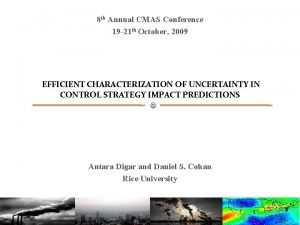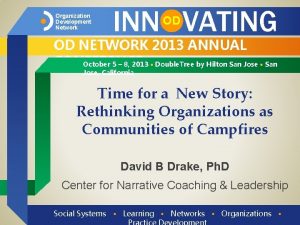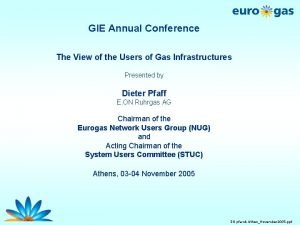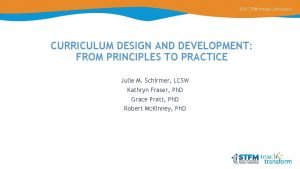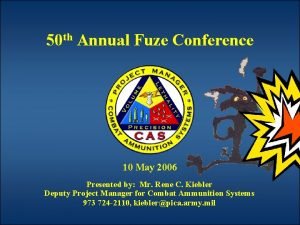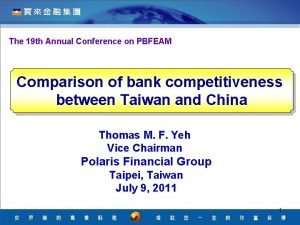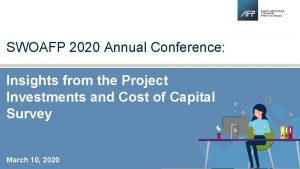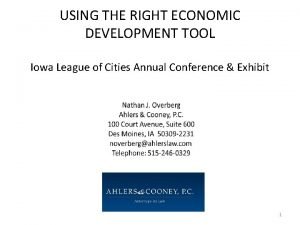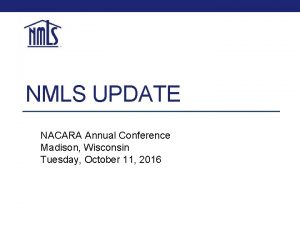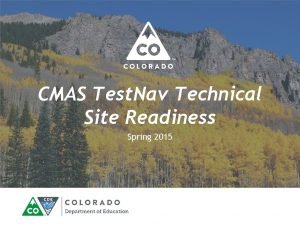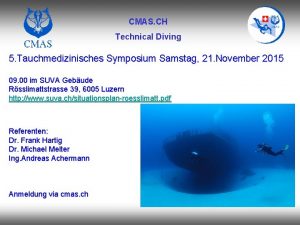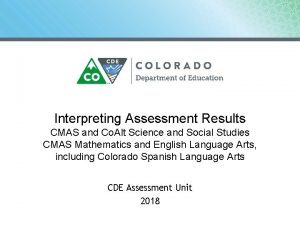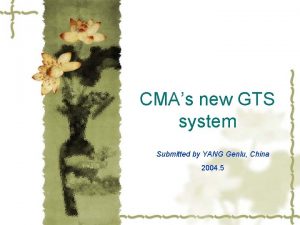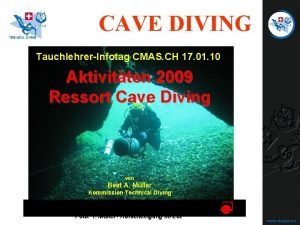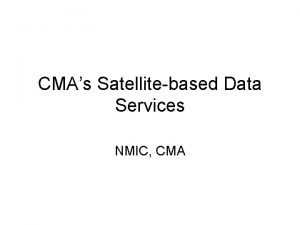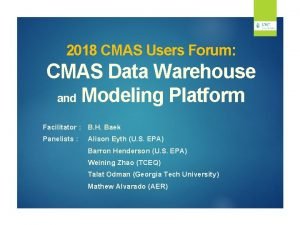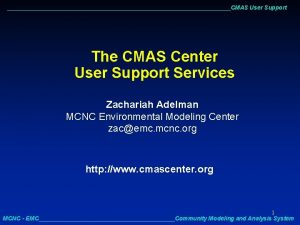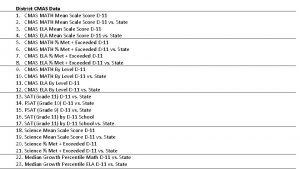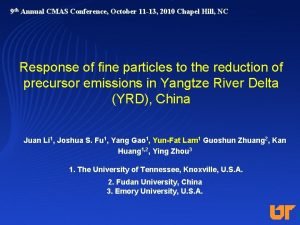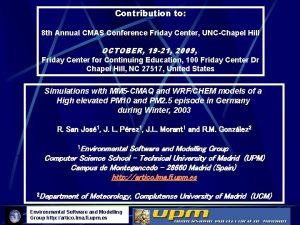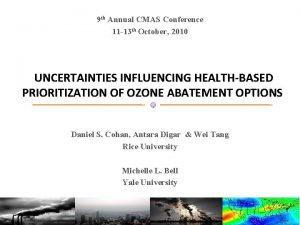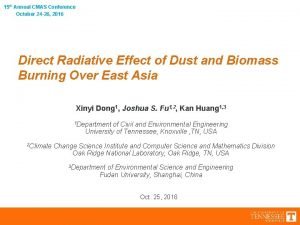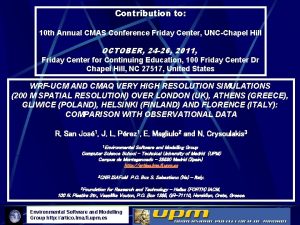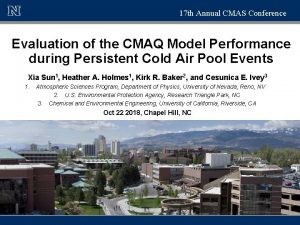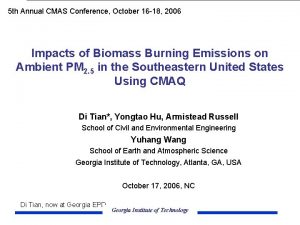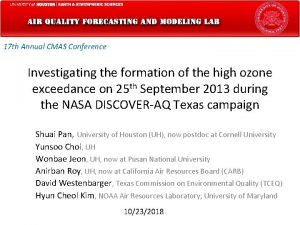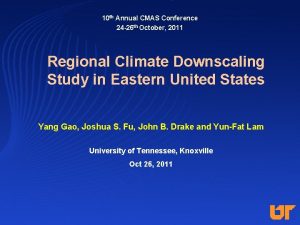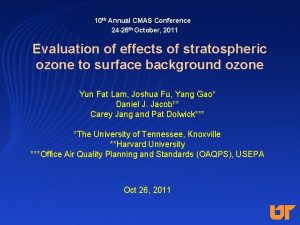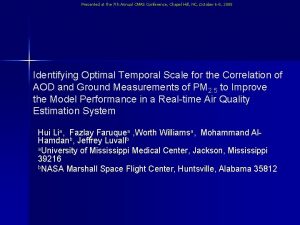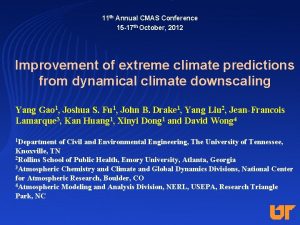14 th Annual CMAS Conference 5 7 th




















- Slides: 20

14 th Annual CMAS Conference 5 -7 th October, 2015 Improvement of Dust Module in CMAQ and Implement of Heterogeneous Chemistry Xinyi Dong 1, Joshua S. Fu 1, Kan Huang 1, Daniel Tong 2, 3, 4, and Guoshun Zhuang 5 1 University 2 NOAA/OAR/ARL, 3 Center of Tennessee, Knoxville NOAA Center for Weather and Climate Prediction for Spatial Information Science and Systems, George Mason University 4 Cooperative 5 Department Institute for Climate and Satellites, University of Maryland of Environmental Science and Engineering, Fudan University Chapel Hill, NC Oct. 5 th, 2015

Outline • Brief review of dust emission scheme in CMAQ • Implement of model developments • Results and discussion

Why we care about dust in CMAQv 5. 0 (Oct. 2012): Wind-blown dust option became available Before : some user-initiated model development studies (Wang et al. , 2012, ACP; David et al. , 2013, AE) After : application of CMAQv 5. 0 in US (Appel et al. , 2013, ACP) & East Asia (Fu et al. , 2014, ACP) Why it’s essential Having dust can promote the model to: Better predictions of Aerosols Inline mode WRF/CMAQ (Yu et al. , 2014, ACP) Hemispheric scale simulation (Jia et al. , 2015, ACP) How it’s unique Speciation of dust particles, enable the model to: Chemical evolution of dust particles (Ca. CO 3, Fe 2 O 3 …) Change of optical properties

Dust Emission Scheme Calculation of dust emission flux (F) is based on modified Owen’s equation (Owen et al. , 1964; Tong et al. , 2015 ) Ratio between vertical and horizontal flux Friction velocity threshold ( if the friction velocity exceeds this threshold, there will be dust particles elevated) Soil erodible potential Initial friction velocity threshold constant for 13 soil types, based on filed data from Gillette et al. (1980). The values in original CMAQ double count the impact of soil moisture, and our recent reanalysis of the field data provide new values of Soil moisture adjusting factor Surface roughness adjusting factor

New Friction Velocity Threshold Constant Land Cover Categories Taklamakan Gobi Tibet Soil Types Initial Friction Velocity Threshold Constants

Source-dependent Speciation Profiles CMAQ default Taklamakan 20% fine mode Dust 80% coarse mode Species Description ACA AMG AK Calcium Magnesium Potassium Mass Conributions (%) Fine Mode (I, J mode in CMAQ ≤ 2. 5μm) Coarse Mode (K mode in CMAQ ≤ 10 μm) Default Taklamakan Gobi 7. 94 2. 063 1. 788 0 1. 423 1. 082 0 0. 165 0. 799 0 0. 121 0. 819 3. 77 0. 153 0. 282 0 0. 108 0. 121 Gobi

Heterogeneous Chemistry Heterogeneous reactions in original CMAQ: C 1 C 2 13 reactions added into CMAQ in this study: R 1 R 8 R 2 R 9 R 3 R 10 R 4 R 11 R 5 R 12 R 6 R 7 R 13 Reaction Rate: : radius of the particle : diffusion coefficient of gas molecules : molecular velocity of gas : uptake coefficient (values from Zhu et al. , 2010, ACP) : particle surface area

Method Fudan observation station in Tazhong Modeling domain and observation stations Tazhong API AERONET EANET TAQMN Fudan Obs. Simulation period: March-April, 2006 -2010 Simulation design Scenario Configuration of WRFv 3. 3/CMAQv 5. 0. 1 Dust_Off Without inline calculation of dust Dust_Default With default dust plume rise scheme Dust_Revised initial friction velocity threshold constant in dust plume rise scheme Dust_Profile Same as Dust_Revised, but with implemented source dependent speciation profile Dust_Chem Same as Dust_Profile, but with implemented dust chemistry with lower limit of uptake coefficient Dust_Chem. High Same as Dust_Chem, but with upper limit of uptake coefficients Dust_Inline Same as Dust_Profile, but with inline WRF/CMAQ

Results: Dust Emission Simulated Dust PM 10 Default Revised PM 10 Bias vs API

Evaluation Statistics Revised dust scheme significantly improve the model’s performance of reproducing PM 10 and AOD over East Asia, but simulation still contain large uncertainties PM 10 vs API Default Revised AOD vs AERONET AOD vs MODIS

Model Improvement – Trace Metals Model evaluations of fine mode trace metals with Default and Revised speciation profiles at Tazhong, Duolun, and Yulin Gobi Taklamakan Duolun Tazhong K+ PM 2. 5 Default Ca 2+ Mg 2+ Revised Default 0. 23 Revised Default Revised Mean Obs (µg/m 3) 81. 52 Mean Sim (µg/m 3) 44. 36 0. 69 0. 12 0. 02 0. 12 3. 06 1. 05 Mean Bias (µg/m 3) Normalized MB (%) Correlation -37. 17 -45. 59 0. 67 0. 46 208. 9 0. 42 -0. 11 -47. 83 0. 44 -0. 17 -99. 8 0. 22 -0. 07 -36. 84 0. 51 0. 82 36. 69 0. 22 -1. 19 -53. 12 0. 44 Default Profile 0. 19 Yulin 2. 24 Revised Profile PM 2. 5

Impact of Dust Chemistry Spatial Distribution with lower uptake coefficient with higher uptake coefficient O 3 Evaluation Statistics Against EANET observation Mean Bias NMB (%) Correlation No_Chem Chem_Low Chem_High O 3 (ppbv) 0. 59 -0. 92 -2. 07 1. 26 -1. 97 -4. 43 SO 2 (ppbv) 0. 62 0. 65 0. 59 0. 64 0. 54 0. 42 0. 38 90. 7 69. 83 63. 7 0. 63 0. 67 (µg/m 3) -0. 71 0. 6 1. 29 -16. 28 13. 74 29. 43 0. 78 0. 75 0. 72 HNO 3 (ppbv) 0. 46 0. 35 109. 03 85. 17 81. 24 NOx (ppbv) 0. 63 0. 67 0. 68 35. 61 37. 79 38. 21 0. 64 0. 7 0. 6 0. 7 0. 58 0. 7 -0. 2 -0. 03 0. 37 -13. 07 -1. 97 24. 09 0. 72 SO 4 2 - NO 3 - (µg/m 3)

Case Study: Dust Strom Mar. 19 -21, 2010 Spatial distribution of simulated AOD is consistent with MODIS product Mar. 19 MODIS CMAQ (revised) Mar. 20 Mar. 21

Case Study: Dust Strom Mar. 19 -21, 2010 Default Revised API EANET x AERONET

Uncertainties (1) PM 2. 5 mass ration in dust emission CMAQ (PM 2. 5/PM 10) Measurement (PM 2. 5/TSP) Tazhong Duolun Yulin 20% 44. 6% 42. 7% 39. 5% (2) Excessive soil moisture in FNL (Zender et al. , 2013; Haustein et al. , 2012) Systematic underestimation of fine mode aerosols (1) Overestimation of (2) Underestimation of T, wind speed

Evaluation of Inline WRF/CMAQ Shortwave radiation flux evaluate against CERES TOA SFC Mean Obs(W/m 2) Mean Sim(W/m 2) MB (W/m 2) NMB (%) Clear sky 66. 14 75. 9 9. 79 14. 80 0. 91 All sky 113. 98 109. 45 -4. 53 -3. 98 Clear sky 282. 03 280. 29 -1. 73 All sky 221. 55 238. 98 17. 43 Evaluate against NCDC observations R Mean Obs Mean Sim MB NMB (%) R T 283. 43 (K) 282. 49 (K) -0. 95 (K) 3. 9 0. 94 0. 89 Humidity 5. 36 (g/kg) 5. 61 (g/kg) 0. 25 (g/kg) 4. 6 0. 95 -0. 61 0. 86 WS 3. 98 (m/s) 4. 86 (m/s) 0. 87 (m/s) 21. 8 0. 71 7. 87 0. 93 WD 239. 57 (°) 258. 03 (°) 18. 46 (°) 7. 7 0. 83 Temperature and Relative Humidity evaluated against MODIS T Height Mean Obs (K) Mean Sim (K) MB (K) 1000 h. Pa 293. 85 294. 20 0. 35 950 h. Pa 290. 77 290. 81 920 h. Pa 288. 98 850 h. Pa NMB (%) R Height Mean Obs (%) Mean Sim (%) MB (%) 0. 12 0. 99 1000 h. Pa 86. 55 87. 20 0. 65 0. 76 0. 64 0. 01 0. 99 950 h. Pa 82. 61 86. 72 4. 11 4. 97 0. 87 289. 22 0. 24 0. 08 0. 98 920 h. Pa 80. 62 82. 98 2. 36 2. 92 0. 90 284. 47 285. 03 0. 55 0. 19 0. 99 850 h. Pa 74. 04 74. 69 0. 64 0. 87 0. 93 780 h. Pa 280. 58 280. 97 0. 39 0. 14 0. 99 780 h. Pa 67. 20 71. 16 3. 96 5. 90 0. 89 700 h. Pa 275. 32 276. 00 0. 68 0. 25 0. 99 700 h. Pa 62. 93 68. 42 5. 48 8. 72 0. 87 620 h. Pa 269. 27 270. 65 1. 39 0. 51 0. 99 620 h. Pa 60. 69 6. 66 1. 98 3. 26 0. 70 500 h. Pa 258. 71 260. 58 1. 87 0. 72 0. 99 500 h. Pa 53. 09 59. 47 6. 38 12. 02 0. 76 RH NMB (%) R

Dust Impact in Two-way WRF/CMAQ Dust induced Shortwave Radiation Change Upward @ TOA Downward @ Surface Compare with other studies Snow cover (NHSNOWM) Region South Korea East China Hengduan Mountains Tibet Plateau Taklamkan Method CCM 3 (Won et al. , 2005) This study CCM 3 (Park et al. , 2005) ADAM (Park et al, 2008) This study MFRSR (Ge et al. , 2011) fv. GCM (Lau et al. , 2006) WRF-Chem (Chen et al. , 2013) This study RTM, CALIPSO (Kuhlmann and Quaas, 2010) This study Dust induced change @ TOA (W/m 2) 5 ~ 10 10 ~ 20 5 ~ 15 -4 ~ 3 -2 -4 -30 ~ 5 Dust induced change @ SFC (W/m 2) -20 ~ -10 -30 ~ -10 -40 ~ -20 -60 ~ -20 ~ -10 -13 -6 -10 ~ -60 - -60 ~ -90 0~5 -20 ~ -40

Summary l Preliminary Conclusions: l Revised friction velocity threshold constants and sourcedependent speciation profiles help to improve the model predictions for PM 10, AOD and trace metals l Large discrepancies still remain due to possible uncertainties from: dust speciation, and soil moisture l Inline mode indicated strong cooling effect of dust particles at surface, especially over snow cover areas l Next steps: l Examine dust particle’s evolution through chemistry with Ca. CO 3 and Fe 2 O 3 l Sensitivity studies to eliminate the uncertainties within fine particles ratio and soil moisture

Acknowledgement We acknowledge Dr. David Wong for his help on reposing technical questions, and NSF National Institute for Computational Sciences (NICS) at the University of Tennessee for providing the computer sources for model simulations of this research.

Thanks !
 Cmas conference
Cmas conference Od network
Od network Edgar figueroa md mph
Edgar figueroa md mph Gie annual conference
Gie annual conference Gcyf 2011 annual conference
Gcyf 2011 annual conference Problemitize
Problemitize Stfm conference
Stfm conference Annual fuze conference
Annual fuze conference Njdv
Njdv Hepi conference
Hepi conference Pbfeam
Pbfeam Afp annual conference 2020
Afp annual conference 2020 Iowa league of cities annual conference
Iowa league of cities annual conference Nmls annual conference 2019
Nmls annual conference 2019 Travel health insurance association annual conference
Travel health insurance association annual conference Anatmia
Anatmia Cmas test nav
Cmas test nav Cmas.ch
Cmas.ch Pgcs score
Pgcs score Mfc cmas
Mfc cmas Höhlentauchen budapest
Höhlentauchen budapest
